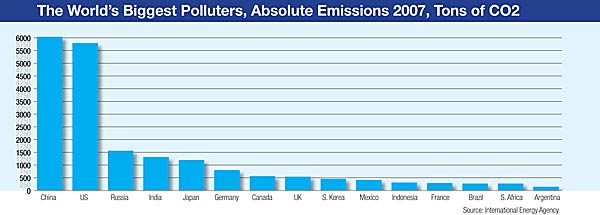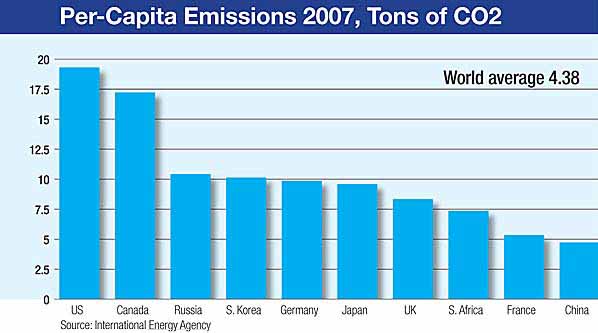Paying For The Green Revolution
Huge investments will be required to enable the world to make the transition to renewable energy sources to cut greenhouse gas emissions and stave off an environmental disaster.
By Gordon Platt
There is little doubt that enormous investment will be needed to address the problem of climate change, but one key question remains unanswered: Where will the money come from? According to analysts and bankers, it is becoming increasingly clear that the bulk of the funding will come from the private sector, and financial institutions will play a key role in directing capital to low-carbon alternatives and providing liquidity for evolving global carbon markets.
US secretary of state Hillary Rodham Clinton announced in Copenhagen in December that the United States is willing to work with other countries toward a goal of mobilizing $100 billion a year by 2020 to address the climate-change needs of developing countries. Much of the money could come from private sources, such as carbon-offset projects purchased under domestic cap-and-trade programs.
“Public finance is important, but private sector investment will play a much bigger role, and how that’s mobilized is a key issue,” says Nobuo Tanaka, executive director of the International Energy Agency. The failure of the Copenhagen summit to reach a binding agreement on a global climate deal will not make that task any easier. Investors were looking to Copenhagen to produce a strong political commitment to move the world along the road toward a legally binding accord. They were frustrated, however, by a handful of developing countries that were holding out for $400 billion a year or even more.
While some world leaders, including US president Barack Obama, described the outcome of the talks as meaningful, the reality remains that commitments made at past global warming conferences have not been honored. Ultimately, the decision of whether to invest in renewable energy will be made by investors taking a cold, hard look at economic realities.
Transparency, longevity and certainty, or TLC, drives investments, according to a policy “green paper” by DB Climate Change Advisors, a unit of Deutsche Bank, which was released to coincide with the Copenhagen round. “There needs to be a transparent process that gives a reasonably certain rate of return over a long timeframe,” the report says. The right mix of TLC can produce job creation with energy security and climate protection at the most efficient cost, according to Deutsche Bank.
Getting the price right will be key to achieving the scale-up of renewable energy necessary to achieve emission-reduction targets, the bank says. Failure to stimulate investor interest will lead to failure to achieve any target, it says. However, overly generous fixed incentives could prove politically difficult to sustain.
Arguably, hundreds of billions of investment dollars, if not trillions, from pension funds, private equity investors, sovereign wealth funds and hedge funds are waiting on the sidelines—capital that is ready to kick-start a shift to a low-carbon economy and create green jobs in the process, Deutsche Bank says. But uncertainty about the regulatory framework has prevented their full deployment, it adds.
The German system of feed-in tariffs for electricity production allows for flexibility as economic conditions change. This policy mechanism has encouraged the adoption of renewable energy sources in volume and has proven to be a powerful incentive to investors and entrepreneurs, Deutsche Bank says.
“Cap-and-trade systems of carbon trading will take a number of years to develop to a global scale,” says Mark Fulton, global head of climate change investment research at Deutsche Bank, who is based in New York. “Meanwhile, mandates, standards and incentives have been driving investments in renewable energy,” he says.
Under a feed-in tariff, utilities are obliged to buy electricity generated by renewable sources, such as solar or wind power, at rates that are based on the cost of producing the electricity. Feed-in tariffs create transparent, long-term and consistent payment mechanisms for the deployment of renewable technologies, Fulton says. The system has worked well in Germany, and it can work in the more complex and fragmented policy framework in the US electricity markets, he says.
“In one sense, it is really simple,” Fulton says. “If you want to scale up renewable energy, which is more expensive to produce than electricity from coal-fired plants, you need to link feed-in tariffs to a renewable portfolio standard [RPS]or renewable energy standard.” An RPS is a regulation that requires utilities to increase the production or purchase of energy from renewable sources.
The combined policy structure creates mandated markets for renewable generators, with guaranteed grid access, and locks in prices for the power they generate. Feed-in tariffs in Germany and in Ontario, Canada, have must-take clauses under which renewable energy receives priority purchase before fossil fuels on the grid. All of the feed-in tariff mechanisms are open to independent power producers (IPPs), communities and large utilities to participate through ownership and investment. In Germany homeowners commonly manage small solar roof generators, while larger installations such as wind farms are owned and operated by community cooperatives and farmers, as well as IPPs.
The extra costs of producing renewable energy can be passed on to the ratepayer, the taxpayer or a combination of both. In New York, for example, Consolidated Edison assesses an SBC/RPS charge of slightly more than 0.3 cents per kilowatt-hour. “The Systems Benefit Charge/Renewable Portfolio Standard charges fund New York State renewable energy, environmental and other related public policy programs,” according to the explanation provided on the Con Edison bill. A temporary New York state surcharge, covering new fees imposed by the state in the midst of a fiscal crisis, is somewhat higher than the renewable energy charge. These are in addition to other tax surcharges that are more than double the green-energy charge.
In September 2009 Con Edison was named to the Dow Jones Sustainability Index for North America. The utility says it has achieved a 34% reduction in greenhouse gas emissions since 2000 as a result of its commitment to continuously improve infrastructure. “The company has reduced sulfur-hexafluoride emissions from electric-distribution equipment, replaced generating equipment with natural-gas-burning combustion turbines, and has implemented cogeneration technologies that reduced greenhouse gas emissions per energy-output unit, among other actions,” it said in a statement.
Encouraging Investment
“The most efficient way to scale up renewable energy sources is to get multiple investors involved, which requires TLC,” Fulton says. Power-purchase agreements (PPAs) in the US are contracts that set long-term prices for electricity. Creating a standard-offer PPA by bundling renewable energy credits at prices set to deliver appropriate returns to investors over a long time period would create a level playing field, according to Fulton. “Everybody would know what they were getting,” he says.
There is obviously an international dimension to what needs to be done on reducing emissions, because national actions are not sustainable in isolation, Fulton adds. “The Copenhagen process is a beginning of this realization,” he says. “But the process needs to include the private sector leveraging public finance, because governments do not have the scale to make the necessary investments.” If the policy mix is right, the private money will flow, he adds.
Deutsche Bank wants to help leverage public funding and to be involved in public-private partnership deals, Fulton says. The best features of feed-in tariffs can be integrated into the renewable energy certificates (REC) markets by establishing a floor price and standardizing the renewable energy contract, he says. This would enable the construction of power-purchase agreements that could be implemented at the state or regional level.
RECs are created when a qualifying renewable energy source delivers power to a grid operator. “RECs are essentially the environmental attributes of the power and can be transferred from generators to utilities or traded among utilities within and across grid-operator borders,” Deutsche Bank says.
A national infrastructure bank, or a “Green Bank” in the US, modeled on the Overseas Private Investment Corporation (OPIC), could mobilize and facilitate capital deployment in renewable energy on a large-scale basis, Deutsche Bank says. “The creation of the new Green Bank could help in US energy policy, which at present lacks an integrated planning and support framework and has historically relied on tax subsidies versus enhanced credit,” according to the bank’s green-policy paper.
Cheap debt issuance alone, even if backed by the full faith and credit of the US government, is unlikely to mobilize large sums of investment, the bank says. Providing flexible debt capital across a variety of tenures that conform to project-specific timeframes and certainty of capital availability are key, it says. “Providing these financing products would fill a large void in the US energy sector, providing highly rated hedgeable instruments that could enable producers and financiers to dynamically adjust their capital at risk and market exposures by timeframe based on changes in fundamentals,” according to the policy paper.
The Green Bank could act as a clearinghouse for structuring and backstopping standard-offer PPAs, Deutsche Bank’s policy paper says. The bank would develop a set of national best practices for clean-energy financing, such as a standard loan application, consistent lending and verification standards.
Reed Hundt, former chairman of the Federal Communications Commission, who is co-head of a lobbying group called the Coalition for the Green Bank, says it would not replace private financing. “Instead, it will be a nonprofit wholesale bank that facilitates sensible, safe, reliable lending by retail banks making a healthy, reasonable profit on this activity,” he says. “We expect the Green Bank will generate hundreds of millions of dollars of profitable, predictable revenue for retail banks.”
Hundt recommends that the bank be capitalized at $25 billion so that it would not be subject to annual appropriations and could operate on a long-term basis. The House-passed climate bill, sponsored by Democratic congressmen Henry Waxman of California and Edward Markey of Massachusetts, includes a provision for a Clean Energy Deployment Administration (CEDA). Designed to replace the Energy Department’s loan-guarantee program, CEDA could eventually be folded into the proposed Green Bank.
With the climate bill bogged down in the Senate, Hundt suggested in December that Congress should pass a jobs bill, which would include the Green Bank. Every $1 billion invested in clean energy produces 10,000 direct job years and three times as many indirect job years, he says.
Pitfalls Loom
The road to a low-carbon society will be a bumpy one with many potential routes. Carbon prices under the European Union’s carbon-trading scheme fell sharply following the Copenhagen climate summit, giving companies less incentive to cut their greenhouse gas emissions. Meanwhile, many alternative energy projects have found it difficult to raise funds because of the credit crunch.
The global financial crisis also has had an effect on research and development spending, which declined by 60% in 2009, according to Angel Gurría, secretary-general of the Organization for Economic Cooperation and Development. This happened just when governments were looking for the innovations and new technologies required to support “green growth” as one way out of the crisis and the only way toward a more sustainable economy, he says.

 |
|
Fulton: To scale up renewable energy sources, you need multiple investors |
With global electricity demand expected to double by 2030, the International Finance Corporation of the World Bank is focusing on financing private sector investment in renewable technologies in emerging market countries. The IFC is backing manufacturers of wind turbines and solar-energy cells and panels in China and India. In December 2009 it created a risk-sharing facility with the Bank of the Philippine Islands (BPI) to enhance the bank’s lending for sustainable energy projects.
“We are taking full advantage of IFC’s support and global experience to help develop our portfolio of sustainable energy loans and leases, and pursuing the perceived higher-risk renewable energy market with greater confidence,” says Gil Buenaventura, BPI’s chief operating officer.
Also in December the IFC announced a $15 million loan to Ameriabank to finance small-scale renewable energy projects in Armenia, including hydropower plants. The IFC also will help Ameriabank assess projects with a focus on environmental and financial aspects. In fiscal 2009 the IFC made more than $1 billion in climate-friendly investments globally.
Not all investors are as focused on climate change, though. According to a report by Ceres, a Boston-based coalition of investors, and environmental and other public-interest groups, a majority of the world’s largest investment managers are not factoring climate-related trends into their investment decisions. “Despite the growing recognition of the far-reaching impacts climate change will have on the global economy, only a handful of asset managers are integrating climate risks and opportunities throughout their investment practices,” says Mindy Lubber, president of Ceres and director of the Investor Network on Climate Risk.
In a survey of 84 asset managers with $8.6 trillion in assets under management, Ceres found that 44% do not consider climate risks at all. Investment managers are overly focused on short-term performance, Lubber says. “They are still only in first gear when it comes to including climate risks in their due diligence,” she says.
Pension funds and other institutional investors either are not asking their asset managers to include climate risk and opportunity analysis or are only beginning to raise the subject. The California State Teachers’ Retirement System (CalSTRS) announced in January that it would engage its active equity managers on their climate risk analysis and voting practices. “As a long-term investor, CalSTRS wants to invest in well-managed companies that can address the physical risks of climate change and adapt to the changing regulatory and market realities of a carbon-constrained economy,” says Jack Ehnes, chief executive officer of CalSTRS, the nation’s second-largest public pension fund.
Despite what some saw as a disappointing outcome to the Copenhagen summit, Lubber says the scientific consensus that climate change is under way is the same today as it was before. “The financial impact is being felt more and more day to day and needs to be integrated into financial analysis,” she says.
Recent national climate pledges are an encouraging sign, according to Deutsche Bank. On November 25, 2009, US president Obama pledged to cut emissions by 17% by 2020 and by 83% by 2050. China announced the next day that it would reduce the energy intensity of its gross domestic product by between 40% and 45% by 2020. Brazil already gets 80% of its power from renewables and has pledged to reduce deforestation by 80% by 2020.

Research by Deutsche Bank indicates, however, that even with these and other pledged cuts, emissions will not be reduced as much as needed by 2020 to limit global warming to 2 degrees Celsius. The bank says policies to reduce carbon market volatility are critical. It suggests the creation of a marketing board with discretion to borrow or lend allowances on a short-term basis to smooth fluctuations in the market, similar to a central bank.



